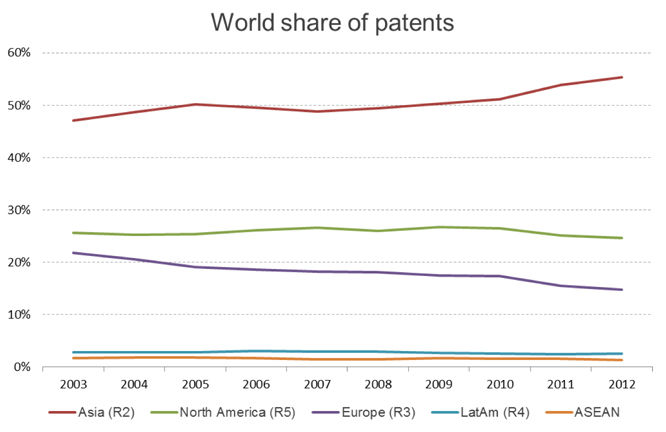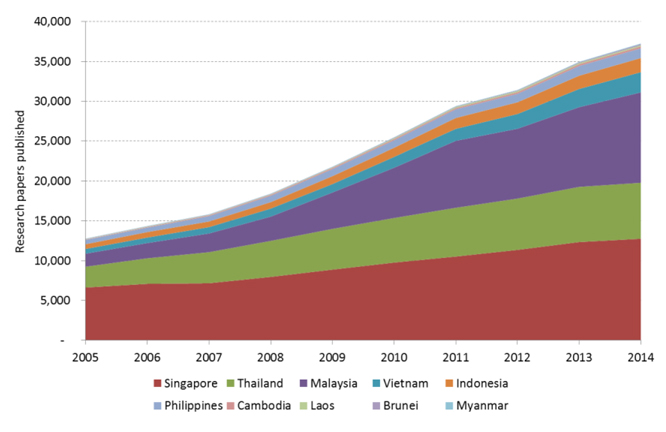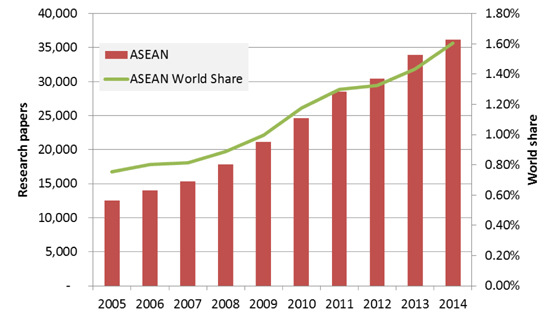



The ecosystem of universities has always been evolving (Ramakrishna and Krishna, 2011; Ramakrishna, 2011a; 2011b), but the change is sharper in recent years. Performance of universities is compared annually and announced publicly by parties external to the universities. The range of areas and parameters used for performance assessment and comparison are growing. This is resulting in further stress on the university leadership at various levels, and in turn on the faculty members and resources of the universities. Universities wish to opt out of global comparisons but they are no longer in a position to do so. Net generation of students i.e. a generation of students born and grew up with internet and digital technologies, with learning expectations different from the earlier generations are now enrolling into the universities. New faculty recruits are far more research oriented and enterprising than earlier generations of faculty members. Policy makers and funding agencies adopting corporate style resource allocation which means based on key performance indicators and strategies of universities. The key stakeholders are seeking new ways to transform and upgrade respective higher education systems. Emphasis is on quality enhancements over simple quantitative expansion. They are encouraging learning from peer institutions, the international education experience (global learning) and university management know-how, advanced teaching methods, reimaging curriculum, and sophisticated approaches to execution. Universities are embracing these changes so as to enable graduates to live and work effectively in the post-globalized world of the 21st Century. Mass production is giving way to mass customization. The post-globalized world is characterized as being global at the same time rooted locally. Learning environments are being updated such that every net generation student is able to absorb relevant knowledge and skills in line with respective dreams, passion, potential and opportunities. Fresh perspectives about life, region and the world to enable students to diversify the choices before them upon graduation. The changing ecosystem points universities to be locally engaged while globally visible. With the exception of top universities in USA, the leading universities in various countries are public. Hence it is even more important for them to be locally engaged firmly while globally visible.
For example, on September 18, 2015 the Singapore Prime Minister Lee Hsien Loong said that “We want to maintain our universities' standing compared to other universities, (and) standing compared to institutions in other countries. And it is very gratifying that we are ranked so high and our hard work has been recognized. But at the same time, we should keep a level head and realize that our universities’ key performance indicator, KPI should not be how high or how low the rankings are. Rather, the KPI should be how well the universities serve Singapore. Whether they are academically and intellectually rigorous and vibrant, yet develop an authentic Singaporean character. Whether they give Singaporeans a good education, not just academically but holistically, building skill sets relevant to the economy so that people can get good jobs and fulfil their aspirations”. He added that there are many challenges ahead as globalization changes the way people work and live.
The following sections describe the emerging trends more deeply and identify specific strategies for the universities to be locally engaged while globally visible. They are relevant to the several universities out of over 20,000 total number of universities in various countries who are entering into the next phase of development and aspire to be relevant to the post-globalized world.
Students who are born and grew up with internet and digital technologies from young age are referred as ‘net-generation’ students (Ramakrishna, 2014a; b). They are now entering into the universities around the world. They have different learning aspirations when compared to the earlier generations in many ways. They come from shrinking, geographically dispersed nuclear families with improved economic conditions. Their friends and family members are all over the world. Their school bag contains lap top, thumb drive, smart phone, lip balm, adopter, charger, etc. instead of texts and paper note books. They are plugged into the global digital brain and networks, and interested in wider exposure and travel. They marry late and seek personal fulfillment. They frequent the digital library over the physical library. They take digital notes over physical notes. They multi-task and search online for information. They seek digital lectures which can be accessed on commute from anywhere and anytime. Earlier generations have taken up jobs which came along their way upon graduation from the university so as to earn a living, pay off debts, and take care of families. Net generation students are more informed about their career options. They have more information about the employer, employee benefits, and future growth opportunities. They are willing to wait out for the right opportunity. They prefer to sample various choices before committing to one. Meanwhile they are embarking on international travel and gaining experiences in different work environments and cultures. Some of them are inclined to establish their own start-up companies as families and society no longer consider such a path is undesirable. They are also influenced by the successful examples of other students, and what they come across from the digital media. One in hundred students are now considering to strike on their own at some point in time during their working life. This rises rapidly to one in ten in the case of students from universities with successful alumni entrepreneurs, and in countries where governments are proactively promoting innovation and entrepreneurship. This is a sea change compared to yester years when one in a thousand students is encouraged to pursue innovation and entrepreneurship. With this backdrop the net generation students seek opportunities to learn and experience innovation and entrepreneurship.
III. Changing Higher Education Eco-system
Universities must be sensitive to the changing expectations of students and work-life continuum in the 21st Century. Internet has created jobs which did not exist before. With continued expansion of the digital technologies and internet, advancements in sustainability designs, low carbon energy, nanotechnology, transportation, construction, healthcare, nutrition, food, and biotechnology likely to create jobs which are not yet conceived. Universities are expected to understand this emerging future and nurture future ready graduates. In a nut shell the university education needs to be reimagined to prepare net generation students for the more fluid post-globalized world with ubiquitous presence of new technologies.
While the digital technologies enabled learning raised the hopes of millions of students around the world, they are yet to improve the learning outcomes of students. A large proportion of universities around the world lack resources to upgrade with newer, faster, better hardware and software. Moreover the digital learning management systems are yet to evolve to the level of being fully user friendly. In addition scarce attention is given to the re-training of faculty members with new learning management systems. Hence the gap between the well-skilled graduates from well-resourced universities and unskilled graduates from poorly resourced universities is widening.
Now a days some graduates prefer flexible working hours as they provide their expertise to several customers at the same time. It is also referred as nano-jobs. In the future it is expected that the graduates will have many jobs in their careers and may even have several careers during their longer life span. They are projected to live up to 100 years (Ramakrishna, 2015).
During their long working lives graduates regularly may need to upgrade with new skills and knowledge. Recognizing the opportunity the online education provider Udacity offers nanodegrees or digital degrees in partnership with leading technology companies. Udacity’s aim is to improve the hireability of its students with certified credentials and endorsed - by the very companies where they want to work. This is made possible by a) creating best-in-class courses taught by expert instructors, b) deploying a responsive and rigorous review model, c) enabling the creation of viable employer-ready work portfolios, and d) equipping students with the presentation skills necessary to show themselves in the best career light possible.
More than 200 million students are enrolled in over 20,000 universities around the world. About 10 to 20 percent of undergraduate students move onto graduate studies and require guidance from the university in making wise choices. About 10 percent of masters students go onto pursue PhD studies in home country or abroad. There is oversupply of PhDs and hence in recent years they are unable to find suitable jobs and opportunities. Hence graduating undergraduate students require guidance in making good choices about a university in a country and research area which match their passion and future career and life expectations. Universities need faculty members who are experienced and aware of opportunities locally and internationally, and who can mentor net generation of students.
In the post-globalized competitive world the nations around the world are paying greater attention to the innovation as it is considered critical for economic growth and sustainability of the country. Innovation enables improved living conditions, healthcare and services, and solutions to the local challenges. Hence the policy makers are expecting universities to make most out of respective research efforts. In other words the universities are to be proactive in innovation and entrepreneurship domains in addition to creation of new knowledge and producing skilled graduates in required numbers. See Figure 1 for the percentage share of patents for Asia, North America, Europe, Latin America and ASEAN regions of the world. See Figure 2 for the research output of ASEAN countries, and Figure 3 for the world share of papers by ASEAN countries.
At the moment there is limited information to the policy makers on how well respective universities are performing in terms of innovation and entrepreneurship. It takes considerable time and efforts to collate information and make useful inferences out of the data. Moreover the universities lack their own databases which are kept well updated with years of data. They have no choice but to rely on external databases for speedy and detailed comparison and analysis of trends. Universities need to invest in their own databases and also linking them to the global databases.
For the first time in 2015 the Thomson Reuters released a list of world’s top 100 most innovative universities
Analyzing the geographical distribution of top innovation universities (Table 1) the global media is quick to report that the US universities are leading the pack as expected, and the Asian universities are catching-up fast (Ramakrishna, 2012; Ramakrishna, 2011). US based universities account for 50% of the Top 100. Japan is next, with 9%, followed by France and South Korea with 8% each, and Germany with 6%. It is assumed that the indicator, industrial-co authorship of research papers, will provide the level at which a university is collaborating with the industry sector on research. The collaboration is estimated based on the share of co-authored papers with industry out of all published papers by the university. The list of patents filed and granted are obtained from the PATSTAT which includes all relevant patent authorities such as the US Patent and Trademark Office (USPTO), the Japanese Patent Office (JPO), World Intellectual Property Organization (WIPO), UK Intellectual Patent Office (UKIPO) and the European Patent Office (EPO). The indicator, publications cited in patents, is aimed at measuring the university’s influence or contribution to inventions or innovation. It looks at the number of citations received by each university’s publication output from patents. Another indicator, publication downloads by the industry sector, is meant for the knowledge transfer between the universities and the industry. It aims to gain insight into the level at which a university’s publication is ‘consumed’ by the industry. This consumption is measured through the number of times a university’s papers have been downloaded by corporations. Finally these indicators were aggregated into the rank order by which the institutions performed to arrive at the top 100 most innovative universities in the world.
[Table 1] Geographical distribution of most innovative universities by Thomson Reuters
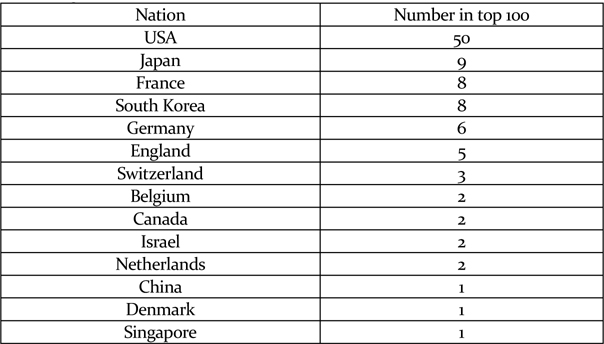
Geographical distribution of most innovative universities by Thomson Reuters
As the countries invest billions in university based research, there will be increased demand for the tangible outcomes and better performance of universities in terms of innovation and entrepreneurship. In the future the most innovative universities are likely to attract further funding from the funding agencies and industry. Such visibility will attract more creative students and enterprising faculty members.
With increased enrollments and investments the universities are akin to large complex organizations. University leadership at various levels need understanding of best practices in terms of academic leadership and management, academic collaborations regionally and internationally, partnership with private sector, curriculum and pedagogical changes, and preparing future ready graduates. In this regard universities need to be proactive in regional and global networks to exchange best practices and learn from each other. In preparation for the future ready graduates, universities have to provide end-to-end service to the students which means recruitment and enrollment, student experiences on and off campus, career services, net-works, and lifelong learning opportunities.
Several universities out of over 20,000 total number of universities around the world are developing plans and strategies to be part of next phase of development of respective countries in a post-globalized world. They are making curriculum and pedagogical changes so as to enable future graduates to live and work effectively in the 21st Century world. Learning environments are being updated such that each and every student is able to absorb relevant knowledge and skills in line with respective dreams, passion and potential. Introducing students to the fresh perspectives about life and the world will diversify the choices before them upon graduation.
These goals require universities to further fine tune the curriculum and pedagogy (Institute-wide Taskforce on the Future of MIT Education, 2013). Unbundle modular curriculum structure such that the student learning experience is carried out in fractal modules form instead of traditional 13 to 15 weeks. In fractal mode the duration is compressed to one week to seven weeks. This mode also leverages the mobile learning enabled by smart phones, high speed and ubiquitous digital world, and new learning management systems. More importantly the unbundled curriculum via fractal modules approach allows for involvement of high quality international faculty members and practitioners from other countries, and experienced professionals from the private sector, public sector and social organizations. This is also referred as ‘externships’. Such a flexibility also enables students to sample internships in diverse sectors of their interest locally and internationally. Moreover the reimagined, unbundled curriculum facilitates novel academic concentrations over traditional majors. Students can also experience research embedded interdisciplinary education which goes together with the innovation and entrepreneurship. These will enable students to explore new vistas which will lead them to emerging and exciting areas. Externships and internships enable students to be ‘glocal’ i.e. they are sufficiently internationalized while rooted locally so that they can work with confidence in the types of cross-border, cross-cultural and cross-functional teams. Such future ready graduates are in line with the emerging work modalities of the 21st Century work environment. Towards this objective, it is also desirable for the universities to have about twenty percent of each cohort of students recruited from the international pool of students with diverse backgrounds and perspectives of work and life. There is a need invest in digital libraries which are accessed differently compared to the traditional university libraries of the past. Digital libraries enable students to gather to leverage information resources and learning materials as they work in collaborative teams and small interest groups.
2. Open-Source Collaborative Platforms
Low skill sets and employability of university graduates is now a demographic problem seen in several countries. For example, in India with close to 5.5 million graduates passing out every year, only about 0.7 million being considered employable by the industry. This situation is attributed to the outdated learning, exam culture, more theory and less or no practice, lack of real world exposure, and mismatch with the workplace needs. Root cause of this situation is lack of adequate infrastructure, resources and well-trained, motivated faculty members and support staff.
Open-source software and hardware platforms are helpful to mitigate this situation. The open-source platforms facilitate collaborations around a small or multi-year multidisciplinary brain stretching projects motivated by the real world challenges. Ideas and better solutions are crowd sourced, analyzed and prototyped. The open-source platforms are co-creation platforms where anyone can propose, collaborate, build and share, a complete ecosystem for creation from concept to product. It is not about diverse people work together but it is about bringing together people who each think differently. Open-source platforms enables students to develop collaborative skills across diverse mind-sets, cultures and approaches. Such skills place them well for life and work in the 21st Century.
Traditionally the universities around the world have focused their efforts on the subject fundamentals, curricula, faculty members qualifications, facilities and infrastructure, credit hours, staff student ratios, accreditation and quality assurance. In recent years with the recognition of preparing students for the globalized world the universities have emphasized the need for good communication skills, multi-cultural skills, interdisciplinary skills, global learning, and ethical and social responsibilities. Stakeholders are now expecting them to be locally engaged by globally visible in a competitive, post-globalized world. They would like the universities to nurture future graduates who are enterprising and create employment instead of seeking employment, and contribute to the respective society. Hence the way forward for the universities now is to introduce new courses on innovation, entrepreneurship, intellectual property, technical and proposal writing, pitching for funding, teaching about open mind and ignorance, and engaging with resident entrepreneurs, and participation in innovation and entrepreneurship competitions nationally and internationally. The changing emphasis of education over the years is captured in Table 2.
[Table 2] Changing emphasis of university education with time
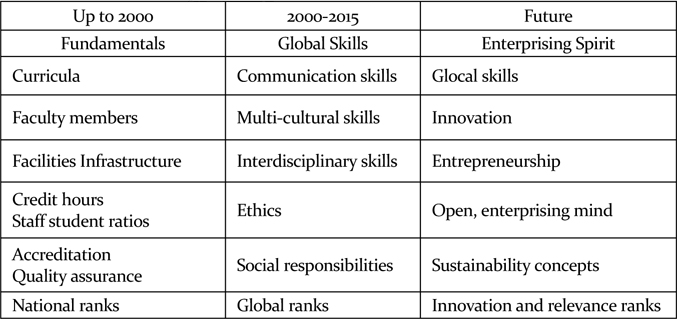
Changing emphasis of university education with time
Most universities focus on leadership development among students, and hence many organizations are finding that they have plenty of leaders but not enough team players. People who see themselves only as leaders can have problems working with others. University education and experiences should also help students to learn when to back off and support others so that more can be done easily and faster while bringing out the best in others. Such skills are also important in the post-globalized world.
Taking the signal from the US National Academy of Engineering report on future engineering education (Byers et al., 2013), the University of Colorado at Colorado Springs innovated its engineering curriculum. About 25 percent of its undergraduate curriculum (~ 30 credits out of 120 total credits) has strong emphasis on innovation and entrepreneurship. This resonates with the US National Academy of Engineering’s suggestion that “in addition to their technical and analytical expertise, engineering students need to be flexible, resilient, creative, empathetic, and have the ability to recognize and seize opportunities. All of these skills can and should be taught to engineers as part of their formal education. It is thus the responsibility of engineering educators to instill these qualities in students to enable them to be more innovative and entrepreneurial”.
Such curriculum innovations and new developments are welcomed by the policy makers as they are finding it difficult to create good employment for growing numbers of university graduates. US Department of Education compared the earnings of alumni of US universities 10 years after the university education
For example, the National University of Singapore, NUS established NUS Overseas Colleges, NOC in innovation hubs around the world which include Silicon Valley and Philadelphia, USA; Shanghai and Beijing, China; Stockholm, Sweden; Bangalore, India; and Israel. Students in this program spend 6-12 months overseas, taking internships in start-up companies. The local equivalent is the Innovative Local Enterprise Achiever Development (iLEAD) initiative, where students intern at innovative Singapore companies. This is a 7-8 month program that cultivates an entrepreneurial mindset, and develops leadership and management skills. NOC set up an entrepreneurial-themed residence, known as N-House. Located within the NUS Prince George's Park residence, this houses graduates of the NOC and iLEAD programs. Entrepreneurial activities are also organized by the N-House residents, and these include entrepreneurial sharing sessions, business idea pitching and networking events. NUS also nurtured tie-up with incubators and accelerators in Singapore and abroad so as to enable enterprising graduates.
4. Cross-border University-public-private Partnerships
Increasingly a multi-party network of local university, foreign university, private sector and public sector is considered necessary for nurturing graduates with future ready skills and knowledge, and accelerate innovation and deployment of solutions to the local as well as global challenges. National governments are allowing substantial international partnerships as well as full-fledged, independent foreign universities to operate on their soil with the intention of upgrading respective higher education systems and rooting the culture of innovation and entrepreneurship. This strategy is also designed to emphasize quality enhancements over simple quantitative expansion, and to encourage learning from peer institutions, the international education experience (global learning), university management know-how, advanced teaching methods, reimaging curriculum and sophisticated approaches to execution. Innovation vouchers are given to the businesses and industry to partner with university researchers to find solutions to the challenges and also accelerate transfer of university research into viable products and services.
Nottingham University in Ningbo, Liverpool University in Suzhou, and Duke University in Kunshan are a few examples in China. As a part of this partnership arrangement they offer two plus two, and three plus two joint degree programs. The National University of Singapore (Suzhou) Research Institute (NUSRI), is a partnership between NUS and the Suzhou Industrial Park Administrative Committee (SIPAC). It is driven by a shared desire to drive research, education and enterprise. This platform is to expand NUS' research and internationalization efforts and contribute to the scientific, economic and industrial thrusts of Jiangsu and China. This institute is also envisioned to serve as a platform for NUS to influence and contribute academically to China and the rest of the world through in-depth cooperation with various parties from China in the areas of technology, education and culture. NUSRI's research efforts span diverse disciplines: advanced electronic devices; biomedical science and engineering; energy and environment technology; agricultural and food science and technology; interactive multimedia and software development; as well as nanomaterials and applications. Eleven research projects headed by NUS investigators have been set up. NUSRI will also focus on creating stimulating and strong education programs for students in China, such as seminars and workshops for business executives. Exchange and immersion opportunities will also be available for NUS students. Another key thrust is the development of enterprise. The Centre for Technology Transfer and Enterprise comprises the NUSRI Incubator that nurtures promising NUS start-up companies in China, and a technology transfer center that provides technology services and facilitates the commercialization of research breakthroughs. Four incubatee firms are currently based at the Institute. NUSRI made four collaborative arrangements with Suzhou-based education institutions and industry partners: a) A joint center on Singapore studies with Renmin University of China Suzhou Campus; b) pre-master program with Wuhan University Suzhou Research Institute; and c) partnerships with Suzhou Great Elevator and Jurong International Constructors (Suzhou) in various fields which encompass product development, executive training and student internships. A year after its inception, NUSRI established three new centers: NUS Business School China Business Centre, Lee Kuan Yew School of Public Policy Suzhou Centre and Institute of Real Estate Studies (IRES) Global Logistic Properties Research Centre. They will conduct research on China business management, innovation in social management, industrial economic research with Chinese characteristics as well as other topical issues that are relevant to China’s social development. Studies conducted at these centers will enhance the overall know-how, capacity and capability of the Suzhou Industrial Park (SIP) in managing issues relating to public administration, commerce, finance, real estate economics and urbanization. NUSRI has grown to over 30 research projects involving more than 40 internationally renowned scholars, and training conducted for more than 1,000 participants. It is currently also incubating 14 startups. In addition to three new research centers, NUSRI will also host the new Singapore-China (Suzhou) Innovation Centre. The Centre aims to promote China-Singapore technology, innovation exchange and commercialization; showcase Singapore technologies and startups in Suzhou; and establish a platform for technology transfer, commercialization and startup incubation.
Operating with a 'glocal' mindset is key for continued success of faculty members over their 40 years of long career. Research priorities of funding agencies change every five years in line with the budgetary plans of new governments. This cycle is even shorter when the research funds come from the businesses. Faculty members with deep expertise in one specific domain are unlikely to succeed in each and every research grant call for several decades. Experimental research is becoming expensive considering the increase in salaries, cost of consumables and enhanced safety standards. With growing number of research active faculty members the competition for the precious research funds can only increase. On the other hand universities expect faculty members to be more productive, influential, and impactful with time in order to move up in the international league tables and show relevance to the society. Herein gives the motivation for the faculty members to explore opportunities beyond borders to further their research and developmental efforts. Enterprising faculty members with ‘glocal mindset’ will be able to contribute to the home university while leveraging opportunities overseas and making an impact both the ecosystems. The final outcome is that they are able enhance the visibility of home university locally and internationally. The ‘glocal faculty members’ pursue the strategy of hub and spoke model of research and education. In other words they use their home university as the hub and develop spokes of collaborations with peers at other institutions around the world. Such collaborations allow the pooling of precious research resources in ways to multiply the benefits available in both places at a lower cost. The glocal faculty members contribute to the international co-authorship of journal papers (see Table 3) there by enhancing the internationalization of home university more efficiently and effectively. They are also able to bring international experience to the students there by giving them first hand and new experiences about the wider world and cultures. They are also able to open up doors for new and exciting opportunities for students and junior researchers. They are also able to leverage the supply chains of research, innovation and entrepreneurship from around the world. Given this background and motivation the aspiring universities need to update their human resources practices and intellectual property rights policies such that the glocal faculty members are encouraged to contribute more effectively. National immigration policies and research funding policies need to be aligned so that the work of glocal faculty members is unimpeded. In the 21st Century by nature most businesses are glocal. Hence it is natural for the businesses and faculty members to work towards the progress of respective stakeholders. Multilateral research funding supports research of excellence on topics of local and global significance, which can be best pursued by a multidisciplinary and multinational approach. Such collaborations are necessary in addressing complex problems such as climate change, food security, health, cybersecurity, urbanization and clean energy. Such collaborations also lead to deeper appreciation of diverse cultures and views. These will enable universities to locally relevant while globally visible.
[Table 3] Internationally co-authored publications of ASEAN countries
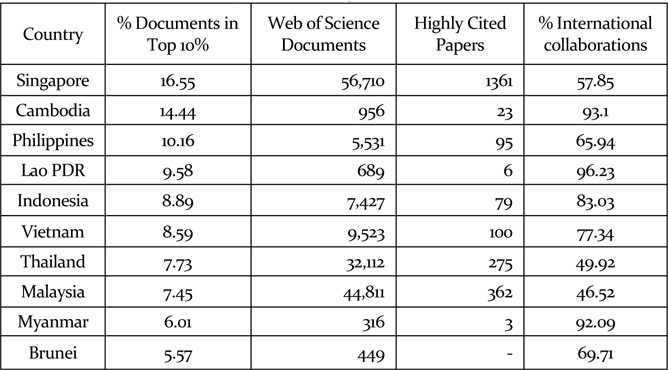
Internationally co-authored publications of ASEAN countries
In a post-globalized competitive world the stakeholders of universities are expecting them to be locally engaged while visible globally. Universities need to reimagine their strategies to meet the expectations in changing higher education landscape. The new ecosystem has multiple facets: a) performance of universities is analyzed and compared more frequently by the third parties on multiple sets of indicators. This information affects the flow of resources to the institutions; b) Net generation of students have new learning expectations compared to the earlier generations; c) new faculty recruits are far more research oriented and enterprising than earlier generations of faculty members; and d) policy makers and funding agencies are adopting corporate style resource allocation which is based on key performance indicators and strategies of universities.
Specific strategies (Ramakrishna, 2015) for the universities to be locally engaged while globally visible include 1) unbundling education using fractal modules approach to facilitate more flexible and customized learning of net generation students; 2) open-source digital and hardware platforms to facilitate collaborations around a short or multi-year multidisciplinary brain stretching projects motivated by the real world challenges; 3) new courses on innovation and entrepreneurship; 4) cross-border university- public- private partnerships for developing solutions specific to the local needs and can be scalable for the world; and 5) encourage faculty members with glocal mindset who pursue hub and spoke model of research and education.
In the years ahead the emerging higher education landscape will see successful universities which are locally engaged while globally visible.
